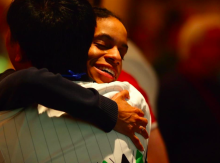Gay Christian Network Conference

At GCNC in 2016, Rev. Broderick Greer spoke to this problem in his keynote address, “Theology as Survival.” In it, he said, “I survived — and am surviving — the strain of being subject to white heterosexist patriarchal theology.”
After the death of Michael Brown, Greer became active on Twitter using the #blacklivesmatter hashtag, and found “stories of black and brown people oppressed, silenced, and erased by white church leaders, pastors, and theologians — or theobrogians, as some of them are affectionately called. And the stories were like mine: incomplete, sore, familiar, frustrated,” he said.

As I spoke to other transgender Christians, I found that many expressed frustration with the lack of education on trans issues in their churches. They told me that even though trans people are being recognized in the media, real and relevant conversations are just not happening in the sanctuary or at Bible study. Maybe folks are worried about saying the wrong thing, or perhaps our churches don’t make space for discussion. Whatever the reason, we as Christians are called into fellowship with one another, and real fellowship takes education and communication. In that spirit, here are seven things that transgender people in your congregation wish you knew.
My first real participation with the tension that exists between the LGBTQ community and the church came when I was a freshman at Penn State University in the spring of 1996. As is the case on many campuses, there was a preacher who would stand outside one of the campus buildings on the green and preach sermons to students. Because he stood outside the Willard Building, he was ‘affectionately’ referred to as the 'Willard preacher.' One spring day, there was a large National Coming Out Day Rally scheduled to happen on campus on the steps of the theater that sat just opposite the Willard Building. When I walked out of my calculus class that day, I had no idea that I would be walking right into the middle of a real live demonstration of the tensions that existed between LGBTQ people and the church. On one set of steps stood a group of students and speakers calling on people to be true to who they were, to not be ashamed of their sexual orientation, and to be open and proud about it. On another set of steps, led by the Willard preacher, a group of students stood chanting, “Sodomy Is Perversion!”
I did not fully understand all that was going on in my heart that day, but I felt like I had to make a choice. One choice I could make was to join the chanters. Now, growing up I had been taught that God did not affirm homosexuality, but I did not feel good about the chanting and jeers that were happening, and I didn’t think I could do that. WWJD, right? I didn’t think this was it. A second choice I could make would be to join the gay pride group. It may seem like an easy choice, but at that time and at that point in my life, I felt that joining this group was a way of saying no to God. I was struggling in my faith, but was I ready to take this step away? I could not see a way that these two groups could peaceably co-exist, and I felt like my faith in Christ was on the line. In the end, I sat down with some friends in the gay pride group.
Fast forward to this past Saturday morning. This time the choice was easier for me. The Westboro Baptist Church had gathered with their signs in protest outside the Oregon Convention Center in Portland, Ore., where the Gay Christian Network was holding their annual conference. As an act of solidarity, support, and protection, Christians from around the Portland area gathered to build a ‘wall of love’ so that conference attenders could enter with little interference from the hateful rhetoric of the Westboro Baptist group.